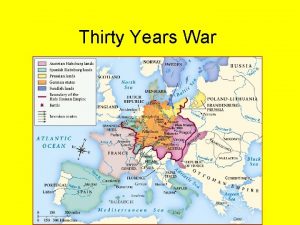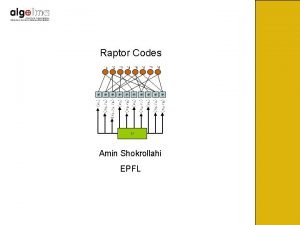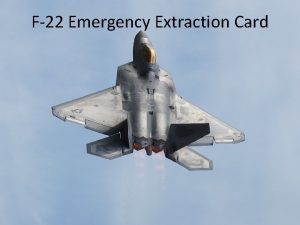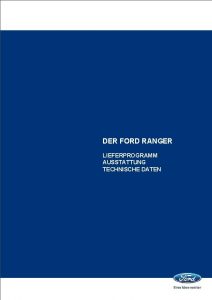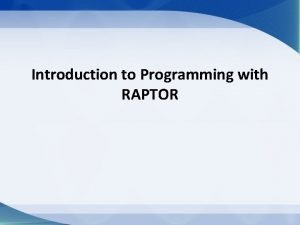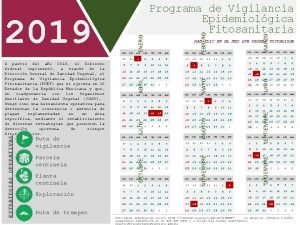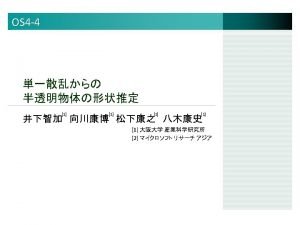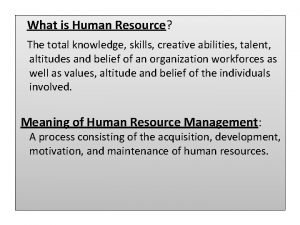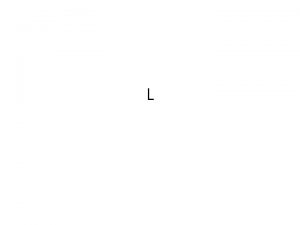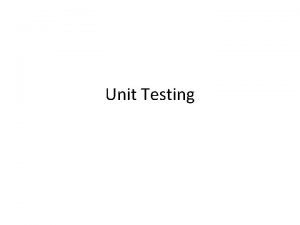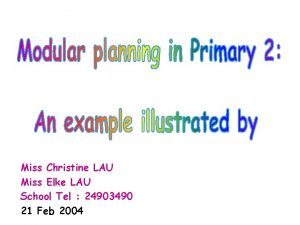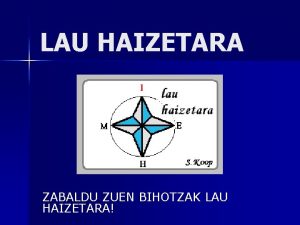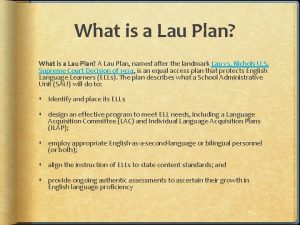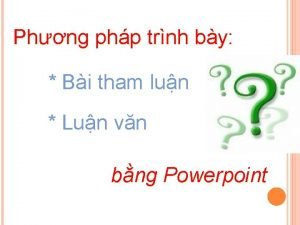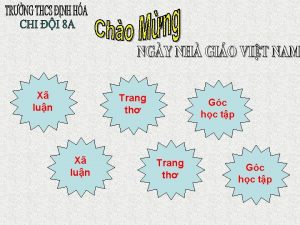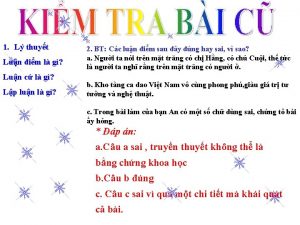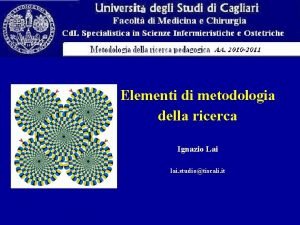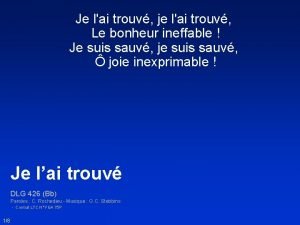Raptor Mr Lau Ka Lun Lai King Catholic




























- Slides: 28

Raptor Mr. Lau Ka Lun Lai King Catholic Secondary School

Introduction • RAPTOR is freely distributed as a service to the CS education community. • It was originally developed by and for the US Air Force Academy, Department of Computer Science. • It is free software. • RAPTOR is a flowchart-based programming environment. • to help students visualize their algorithms and avoid syntactic baggage. • RAPTOR programs are created visually and executed visually by tracing the execution through the flowchart. • Required syntax is kept to a minimum.

Website • http: //raptor. martincarlisle. com/

Layout • Mode -> Novice • Run the program • Pause • Stop • Speed of running • Generate source code

Program Structure • When executing a RAPTOR program, you begin at the Start symbol and follow the arrows to execute the program • A RAPTOR program stops executing when the End symbol is reached.

RAPTOR Statements/Symbols • The top four statement types: – Assignment, Call, Input, and Output • The bottom two types: – Selection and Loops

RAPTOR Variables Description Value of X When the program begins, no variables exist. In RAPTOR, variables are automatically created when they are first used in a statement. Undefined The first assignment statement, X← 32, assigns the data value 32 to the variable X. 32 The next assignment statement, X←X+1, retrieves the current value of X, 32, adds 1 to it, and puts the result, 33, in the variable X. 33 The next assignment statement, X←X*2, retrieves the current value of X, 33, multiplies it by 2, and puts the result, 66, in the variable X. 66 Program

Common errors when using variables

Input Statement/Symbol

Assignment Statement/Symbol • Variable ← Expression

Operators and Functions Operation + * / ^ ** rem mod Description addition subtraction negation multiplication division exponentiation, raise a number to a power Example 3+4 is 7 3 -4 is -1 -3 is a negative 3 3*4 is 12 3/4 is 0. 75 3^4 is 3*3*3*3=81 3**4 is 81 remainder (what is left over) when the right operand 10 rem 3 is 1 10 mod 4 is 2 divides the left operand sqrt log abs ceiling floor sin cos tan cot arcsin square root natural logarithm (base e) absolute value rounds up to a whole number rounds down to a whole number trig sin(angle_in_radians) trig cos(angle_in_radians) trig tan(angle_in_radians) trig cotangent(angle_in_radians) trig sin-1(expression), returns radians sqrt(4) is 2 log(e) is 1 abs(-9) is 9 ceiling(3. 14159) is 4 floor(9. 82) is 9 sin(pi/6) is 0. 5 cos(pi/3) is 0. 5 tan(pi/4) is 1. 0 cot(pi/4) is 1 arcsin(0. 5) is pi/6 arcos trig cos-1(expression), returns radians arccos(0. 5) is pi/3 arctan arccot random trig tan-1(y, x), returns radians trig cot-1(x, y), returns radians generates a random value in the range [1. 0, 0. 0) Length_of returns the number of characters in a string variable arctan(10, 3) is 1. 2793 arccot(10, 3) is 0. 29145 random * 100 is some value between 0 and 99. 9999 Example ← "Sell now" Length_of(Example) is 8

Procedure Call Statement/Symbol

Examples

Examples (cont. ) Read_Scores Calculate_Average_Score Print_Those_Above_Average

Output Statement/Symbol

Comments in RAPTOR

Sequential Program Control • in sequence • one-after-the-other

Selection Control

relational and logical operators Operation = != /= Description "is equal to" "is not equal to" Example 3 = 4 is No(false) 3 != 4 is Yes(true) 3 /= 4 is Yes(true) < <= > >= and "is less than" "is less than or equal to" "is greater than or equal to" Yes(true) if both are Yes 3 < 4 is Yes(true) 3 <= 4 is Yes(true) 3 > 4 is No(false) 3 >= 4 is No(false) (3 < 4) and (10 < 20) is Yes(true) or Yes(true) if either are Yes (3 < 4) or (10 > 20) is Yes(true) xor Yes(true) if the "yes/no" values Yes xor No is Yes(true) are not equal not Invert the logic of the value Yes if No; No if Yes not (3 < 4) is No(false)

Selection Control Examples

Cascading Selection statements

Loop (Iteration) Control

Input Validation Loops

Counting Loops Statements to be repeated

Input Loops

"Running Total" Loops

"Counting" Loops

Exercises • Write a series of RAPTOR statements that determines if X has the value 1, 2, or 3, and prints out “ONE”, “TWO”, or “THREE” accordingly. • Write a complete program that converts between degrees Fahrenheit and Celsius. The user must first enter the conversion that is desired (F to C or C to F) using any means you want and then enter the value to be converted. The formulas for conversion are: F = 9/5 C + 32 and C = 5/9 (F – 32) • Write a complete program that plays the game of HI-LO. The program asks one user for a number between 1 and 100 and verifies that such a number has been entered. It then asks a second user for a guess and reads it in. If the guess is correct a congratulation message is written to the screen and the program ends. Otherwise the message “HI” or “LOW” is displayed (if the guess is higher or lower) and another guess is asked for and read in.
 Raptor.martincarlisle.com
Raptor.martincarlisle.com Kop chai lai lai
Kop chai lai lai Catholic king
Catholic king Raptor school safety
Raptor school safety Franklin academy boynton beach
Franklin academy boynton beach Amin shokrollahi
Amin shokrollahi F22 raptor exhaust
F22 raptor exhaust Ford ranger abmessungen
Ford ranger abmessungen Crisisgo competitors
Crisisgo competitors Raptor emergency management
Raptor emergency management Raptor kiosk
Raptor kiosk Quienes se iran en el rapto
Quienes se iran en el rapto Herbicida raptor 70 dg
Herbicida raptor 70 dg Raptor wing shapes
Raptor wing shapes Flowchart symbol for assignment statement
Flowchart symbol for assignment statement Raptor school safety
Raptor school safety Cchaj lun
Cchaj lun Lun 3
Lun 3 Kam lun tailors
Kam lun tailors Jetel jaky vzor
Jetel jaky vzor Www.lun
Www.lun Mie jue
Mie jue Daniel lun
Daniel lun Lun de tanke
Lun de tanke Lun shape
Lun shape Lun.comn
Lun.comn Kirsten lau
Kirsten lau Human resource cost accounting
Human resource cost accounting Toyota technical poster
Toyota technical poster


